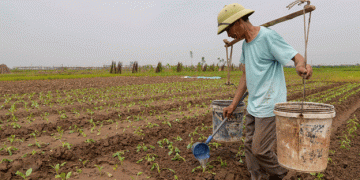Minh Tân village in Hanoi’s Phú Xuyên district, known for its vast vegetable-growing areas, is witnessing a transformation in its agricultural landscape. With over 160 hectares dedicated to vegetable farming, the local economy has been gradually transitioning from traditional farming to a more technology-driven, sustainable approach. Chairman Đinh Văn Thủy of Minh Tân People’s Committee reports that out of the village’s 587 hectares of agricultural land, vegetable farming now constitutes a major portion. This shift is helping boost both productivity and income for local farmers, many of whom are middle-aged or elderly.
The village, home to more than 16,000 people, has seen about 30% of its workforce move to industrial jobs over the past few years. However, around 70% remain engaged in agriculture, particularly vegetable farming—a sector that is evolving rapidly as farmers adopt scientific and technological innovations. With an average per capita income of over 71 million VND in 2023, labor in industrial zones earns between 8 to 15 million VND per month. Meanwhile, older farmers who continue to cultivate crops on 2-3 sào (each about 360 square meters) earn about 30-40 million VND annually.
Despite facing setbacks like the flood caused by Typhoon Yagi, which devastated much of the vegetable crops, Minh Tân’s farmers are resilient. Rebuilding their farms and focusing on sustainability, they continue to grow high-quality vegetables. However, to make the vegetable industry more sustainable, three critical issues need to be addressed: improving infrastructure for transportation and irrigation, upgrading pumping systems, and providing support for the construction of greenhouses and net houses.
Minh Tân began implementing land consolidation efforts in 2014-2015, but vegetable plots still face challenges due to uneven terrain. The fragmentation of land, with many households owning 2-3 small plots, hampers efficient production. In response, some farmers have taken up organic vegetable farming right in their home gardens, an approach that has proven lucrative. For instance, some households grow vegetable seedlings, which are in high demand, especially after natural disasters.
Ms. Hoàng Thị Loan from Kim Quy village earns around 50-60 million VND annually from her 2 sào of land, where she grows crops like bitter melon in the summer and vegetable seedlings in the fall and winter. Vegetable seedlings, such as kohlrabi, fetch high prices—about 800 VND per plant, a 100-200 VND increase due to high demand following the storms.
To meet market demands for both quantity and quality, farmers in Minh Tân have formed cooperatives. The Phù Đổng Minh Tân Safe Vegetable Cooperative, consisting of 13 members, specializes in growing leafy greens, kohlrabi, cabbage, and Japanese edamame. The cooperative follows VietGAP (Vietnamese Good Agricultural Practices) standards, and their produce is distributed to supermarkets such as Big C Thăng Long and industrial zones in Phú Xuyên and nearby Hà Nam province. The cooperative’s annual revenue exceeds 1 billion VND, with each member earning more than 100 million VND per year.
In mid-2023, Minh Tân began sourcing water from the Hồng River for irrigation, replacing the previously used well water, which was not up to sanitary standards. This new water supply has significantly boosted the production of safe vegetables.
The village is also shifting toward organic farming, which is seen as the future of agriculture. Minh Tân has designated a 2-hectare area for organic farming, with 20 households set to experiment with organic practices. While organic farming requires higher investments and more labor, stable market demand and higher prices are key to encouraging wider adoption among local farmers.
In addition to vegetables, Minh Tân has approximately 50 hectares dedicated to aquaculture and 170 hectares to integrated farming models that combine crops with livestock and fruit trees. These initiatives aim to turn Minh Tân into a hub for safe, high-quality produce, contributing to the new rural development (NTM) program. Minh Tân achieved NTM status in 2017 and is on track to reach “advanced NTM” status by 2025. As of now, 16 out of 19 criteria have been met, with income expected to reach 73-75 million VND per person per year.
Food safety is a priority in Minh Tân. The village regularly tests its produce for safety, with 50% of farmers using organic fertilizers and 95% using biological plant protection products. The Phú Xuyên Agricultural Service Center tests vegetable samples twice a year, while the cooperative itself conducts additional tests. All results have shown that Minh Tân’s vegetables meet safety standards.
Minh Tân’s approach to food safety extends beyond vegetables to local schools and households, with comprehensive checks ensuring the quality of food consumed by residents.
Minh Tân’s journey toward sustainable agriculture exemplifies how small-scale farmers can modernize and adopt safer practices while maintaining traditional values. By investing in infrastructure, forming cooperatives, and exploring organic farming, the village is not only ensuring a stable income for its residents but also contributing to the larger goal of developing high-quality, safe agricultural products. As the village moves forward, the key to success will lie in balancing innovation with the preservation of local farming traditions.































